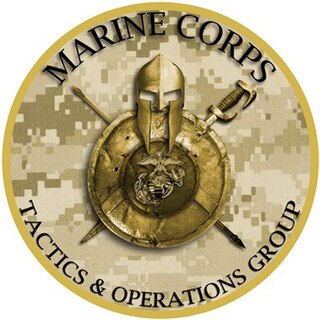Network-centric warfare, also called network-centric operations or net-centric warfare, is a military doctrine or theory of war that aims to translate an information advantage, enabled partly by information technology, into a competitive advantage through the computer networking of dispersed forces. It was pioneered by the United States Department of Defense in the 1990s.

The Combat Capabilities Development Command (CCDC) C5ISR Center, formerly the Communications-Electronics RD&E Center (CERDEC), is the United States Army information technologies and integrated systems center. CCDC C5ISR Center is headquartered at Aberdeen Proving Ground in Maryland, with activities at Fort Belvoir in Virginia and Joint Base McGuire-Dix-Lakehurst in New Jersey.
The Army Battle Command System (ABCS) is a digital Command, Control, Communications, Computers and Intelligence (C4I) system for the US Army. It includes a mix of fixed/semi-fixed and mobile networks. It is also designed for interoperability with US and Coalition C4I systems.
Net-centric Enterprised Solutions for Interoperability (NESI) is a joint effort between the United States Navy’s Program Executive Office for C4I & Space and the United States Air Force’s Electronic Systems Center. It provides implementation guidance which facilitates the design, development, maintenance, evolution, and use of information systems for the Net-Centric Operations and Warfare (NCOW) environment. NESI has also been provided to other Department of Defense (DoD) services and agencies for potential adoption.

Marine Corps University is a military education university system of the United States Marine Corps. It is part of the Naval University System and accredited by the Commission on Colleges of the Southern Association of Colleges and Schools to award Master's Degrees.

The Naval Information Warfare Center Pacific, formerly the Space and Naval Warfare Systems Center Pacific, the Naval Command, Control and Ocean Surveillance Center (NCCOSC) RDT&E Division, the Space and Naval Warfare Systems Center San Diego, and the Naval Ocean Systems Center (NOSC), provides the U.S. Navy with research, development, delivery and support of integrated command, control, communications, computers, intelligence, surveillance and reconnaissance (C4ISR), cyber and space systems and capabilities across all warfighting domains. The only Naval technical center headquartered in a major fleet concentration area, NIWC Pacific manages strategic locations both in the Pacific theater and around the world.

The Naval Information Warfare Systems Command (NAVWAR), based in San Diego, California, is one of six SYSCOM Echelon II organizations within the United States Navy and is the Navy's technical authority and acquisition command for C4ISR, business information technology and space systems. Echelon II means that the organization reports to someone who, in turn, reports directly to the Chief of Naval Operations on the military side. From a civilian perspective, NAVWAR reports to the Assistant Secretary of the Navy (RDA). The command was formerly known as Space and Naval Warfare Systems Command (SPAWAR) and was renamed in June 2019 to better align its identity with its mission.

The Marine Corps Systems Command (MCSC) is the acquisition command of the United States Marine Corps, made up of Marines, sailors, civilians and contractors. As the only systems command in the Marine Corps, MCSC serves as Head of Contracting Authority and exercises technical authority for all Marine Corps ground weapon and information technology programs. MCSC is headquartered at Marine Corps Base Quantico.

Command and control is a "set of organizational and technical attributes and processes ... [that] employs human, physical, and information resources to solve problems and accomplish missions" to achieve the goals of an organization or enterprise, according to a 2015 definition by military scientists Marius Vassiliou, David S. Alberts, and Jonathan R. Agre. The term often refers to a military system.

The Operational Test and Evaluation Force (OPTEVFOR) is an independent and objective agency within the United States Navy for the operational testing and evaluation (OT&E) of naval aviation, surface warfare, submarine warfare, C4I, cryptologic, and space systems in support Navy and Department of Defense acquisition programs.
Marine Corps Operational Test and Evaluation Activity (MCOTEA) is the independent Operational Test and Evaluation (OT&E) authority for the U.S. Marine Corps. MCOTEA plans, executes, and evaluates testing of material solutions against warfighter capabilities, under prescribed realistic conditions and doctrine, to determine Operational Effectiveness, Operational Suitability, and Operational Survivability (OE/OS/OSur) of all new equipment for the Corps in support of its acquisition process. MCOTEA is based at Marine Corps Base Quantico. Unlike most Marine Corps organizations, MCOTEA has a Director instead of a Commander.

The Project Manager Force Battle Command Brigade and Below is a component of the Program Executive Office Command Control and Communications Tactical Special Projects Office in the United States Army. The phrase "brigade and below" in the name refers to the fact that operations and communications within these smaller Army units are shifting to a digital integration.

Marine expeditionary unit (special operations capable) (MEU(SOC)) is a program created by the United States Marine Corps (USMC) and the United States Navy (USN) in 1985 for Marine expeditionary units (MEU). The program enhances MEUs providing them with additional training and equipment to become certified as special operations capable with a Maritime Special Purpose Force (MSPF). The designation special operations capable is unique to the Marine Corps and means in relation to special operations. The role of a MEU(SOC) however is not equivalent to the special operations role of special operations forces. Although considered special operations capable a MEU(SOC) does not form part of the United States Special Operations Command (USSOCOM) established in 1987 or the United States Marine Forces Special Operations Command (MARSOC) later established in 2006.
The reconnaissance mission within the United States Marine Corps is divided into two distinct but complementary aspects; Marine Division Recon and Force Reconnaissance.

The Marine Corps Tactics and Operations Group (MCTOG) provides advanced and standardized training in Marine Air-Ground Task Force (MAGTF) Operations, Combined Arms Training and Unit Readiness Planning at the Battalion and Regiment levels, and synchronizes doctrine and training standards IOT enhance combat preparation and performance of Ground Combat Element (GCE) units in MAGTF operations. They fall under the command of the Training and Education Command. It was established by General James T. Conway, Commandant of the Marine Corps.

PM WIN-T is a component of Program Executive Office Command, Control and Communications-Tactical in the United States Army. PM WIN-T has been absorbed into PM Tactical Networks as Product Manager for Mission Networks.

The Assistant Secretary of the Navy (Research, Development and Acquisition) (abbreviated ASN (RDA)) is a civilian office of the United States Department of the Navy. The Assistant Secretary of the Navy (Research, Development and Acquisition) requires Senate confirmation, and engages in duties as directed by the United States Secretary of the Navy.

The Joint Deployable Analysis Team (JDAT) is part of the J6 Directorate of the Joint Chiefs of Staff.
Marine Tactical Data System, commonly known as MTDS, was a mobile, ground based, aviation command and control system developed by the United States Marine Corps for the execution of anti-air warfare in support of the Fleet Marine Force (FMF). It was the Marine Corps' first semi-automated system capable of collecting, processing, computing and displaying aircraft surveillance data while also sharing that information with other participating units via tactical data link. The system was developed in the late 1950s/early 1960s when it was recognized that due to the speed, range and complexity of fighter aircraft operations effective air control and air defense demanded enhanced situational awareness.

The Naval Information Warfare Systems Command Program Executive Offices(PEOs) are organizations responsible for the prototyping, procurement, and fielding of C4ISR (Command, Control, Communications, Computers, Intelligence, Surveillance and Reconnaissance), business information technology and space systems. Their mission is to develop, acquire, field and sustain affordable and integrated state of the art equipment for the Navy.














